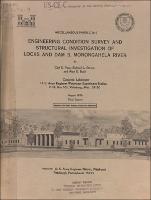Please use this identifier to cite or link to this item:
https://hdl.handle.net/11681/11479Full metadata record
| DC Field | Value | Language |
|---|---|---|
| dc.contributor | United States. Army. Corps of Engineers. Pittsburgh District | - |
| dc.contributor.author | Pace, Carl E. | - |
| dc.contributor.author | Stowe, Richard L. | - |
| dc.contributor.author | Buck, Alan D. | - |
| dc.date.accessioned | 2016-06-20T14:19:57Z | - |
| dc.date.available | 2016-06-20T14:19:57Z | - |
| dc.date.issued | 1976-08 | - |
| dc.identifier.uri | http://hdl.handle.net/11681/11479 | - |
| dc.description | Miscellaneous report | - |
| dc.description | Abstract: The results of an engineering condition survey and a structural analysis of Locks and Dam 3, Monongahela River, are given. External cracking of the concrete in the lock walls is extensive. Many horizontal and vertical cracks, although isolated and not fitting into a total failure picture, can result in localized failures, especially in critically stressed regions. The outer 2 to 6 ft of concrete as described in the core and photo logs are highly deteriorated. The same condition probably exists in the outer surface of the walls to lower pool. The internal concrete is generally of adequate strength for current design criteria. One exception is a small zone in the downstream gate monolith of the middle wall; a compressive strength of 1150 psi was obtained on the concrete from this zone. The concrete is in a critically stressed area; immediate remedial action is recommended. Pressure grouting as an interim measure is suggested. There is one possible continuous crack in gate monolith R-23; it runs for a depth of 35 ft and possibly extends for two-thirds of the monolith to the riverside. The borehole data indicate a consistent pattern of fractured concrete especially in the lower portions of the monoliths. This can be a significant factor tending to produce problems even at moderately high stresses. The foundation appears to be in good condition over most of the lock site. Several local zones of highly fractured rock and one zone where a monolith bears on coal, R-12, are the only zones considered as possible weak rock. During dewatering of the locks, these local foundation conditions could contribute to serious failures of lock wall sections. Such failures could occur due to inadequate sliding resistance of some foundation materials at or near the concrete-foundation contact. There are no detectable continuous discontinuities, zones of fracture, or seams of weak material; bedding planes are the only detectable continuous features over the lock site. The stability analysis reflects deficiencies in many areas: a. In general the monoliths in the land wall do not comply with current criteria for overturning, sliding, or allowable base pressures. b. Some middle wall monoliths do not have adequate resistance to sliding. c. Some monoliths in the river wall do not have adequate resistance to sliding, and where coal seams underlie monoliths critical situations can exist if the river lock is ever dewatered. Bearing pressures are excessive in the upper guard wall causing it to tilt riverward. The stability analysis for the land wall monoliths shows severe inadequacies and as with the guard wall and the abutment, it is probable that stability problems will develop. These problems can cause considerable delays to navigation through these locks. The upper guard wall has excessive bearing pressures between the upper and lower timber cribbing sections and has tilted riverward. There are probably some rocks between the cribbing members which result in more bearing area and, therefore, reduce the calculated stresses considerably. However, the tilting of the guard wall shows that the bearing pressures are still excessive. Tow impact can cause this guard wall to fail. Cracking and deterioration of the exposed concrete are severe problems and are significant at stress concentrations. Stress analysis shows that gouges and concrete deterioration can become problems in the upper guide wall. Excessive stress concentrations exist in the structural slab over the filling and emptying flume. Tensile stresses indicate magnitudes that are excessive for even good quality concrete. Compressive stresses indicate magnitudes that would not be considered excessive for sound, uncracked concrete; however, for badly deteriorated concrete, they are excessive. Stress concentrations also exist at gate anchorages. As the concrete at Locks and Dam 3 continues to deteriorate, stress magnitudes under existing loading conditions, as has been observed, will become a problem. The locks have apparently functioned well for over 70 years, but this cannot be expected to continue indefinitely because of accelerating deterioration due to concrete cracking, leaching, and exposure to a freezing-and-thawing environment. These locks and dam will have to be replaced or rehabilitated. It is recommended that a study be initiated immediately to evaluate rehabilitation or replacement of Locks and Dam 3 on the Monongahela River. | - |
| dc.publisher | Concrete Laboratory (U.S.) | - |
| dc.publisher | Engineer Research and Development Center (U.S.) | - |
| dc.relation | http://acwc.sdp.sirsi.net/client/en_US/search/asset/1044034 | - |
| dc.relation.ispartofseries | Miscellaneous paper (U.S. Army Engineer Waterways Experiment Station) ; C-76-9. | - |
| dc.rights | Approved for public release; distribution is unlimited. | - |
| dc.source | This Digital Resource was created from scans of the Print Resource. | - |
| dc.subject | Condition survey | - |
| dc.subject | Dams | - |
| dc.subject | Locks | - |
| dc.subject | Locks and Dam 3 | - |
| dc.subject | Stability analysis | - |
| dc.subject | Stress analysis | - |
| dc.subject | Structural evaluation | - |
| dc.title | Engineering condition survey and structural investigation of Locks and Dam 3, Monongahela River | - |
| dc.type | Report | en_US |
| Appears in Collections: | Miscellaneous Paper | |
Files in This Item:
| File | Description | Size | Format | |
|---|---|---|---|---|
| MP-C-76-9.pdf | 13.93 MB | Adobe PDF |  View/Open |